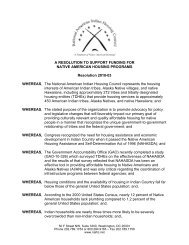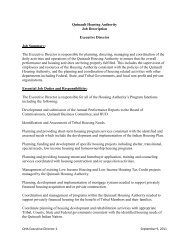CASE STUDY - National American Indian Housing Council
CASE STUDY - National American Indian Housing Council
CASE STUDY - National American Indian Housing Council
Create successful ePaper yourself
Turn your PDF publications into a flip-book with our unique Google optimized e-Paper software.
The proposed homes were as follows:• 65 single-family homeownership units ranging from three to five bedrooms insize• 25 two-bedroom homeownership cottage units for elders and singles• 30 multi-family rental unitsThe homes were designed to be energy efficient and also pre-wired for computer networkcapability.How did ISWA Development Corporation finance the project?The total cost of Green Earth was estimated at $10.8 million dollars, with$5,300,000 provided by First Union Bank under the Title VI loan guarantee program.The project is to be carried out over a three-year period.FINANCIAL RESOURCESThe development of Green Earth started in 1998. Funding for the project wasleveraged from the following financial resources and participating entities:• HUD <strong>Indian</strong> <strong>Housing</strong> 1937 Act funds• NAHASDA funds (FY 1998 through 2003)• HUD Rural <strong>Housing</strong> and Economic Development funds• <strong>Indian</strong> Health Services (sewer and water)• Community Development Block Grant• South Carolina <strong>Housing</strong> Trust• First Union Bank under the Title VI Loan Guarantee ProgramPROJECT TEAMThe team established to carry out the project was as follows:Project TeamTribal <strong>Council</strong>Environmental ComplianceNatural Resource BoardCultural Preservation ProjectBoardRole• Responsible for acquiring land and placing it intotrust status• Provided resolution for TDHE to operateindependently• Provided input on conservation and naturalresources• Provided input on cultural preservation8




